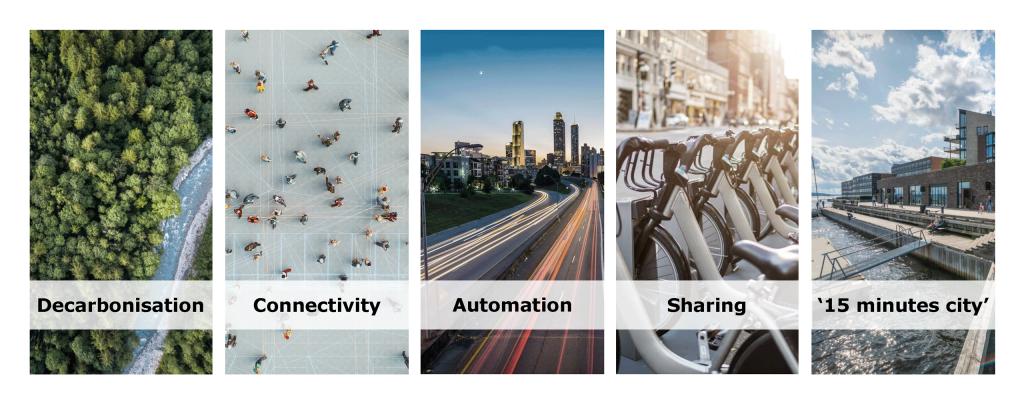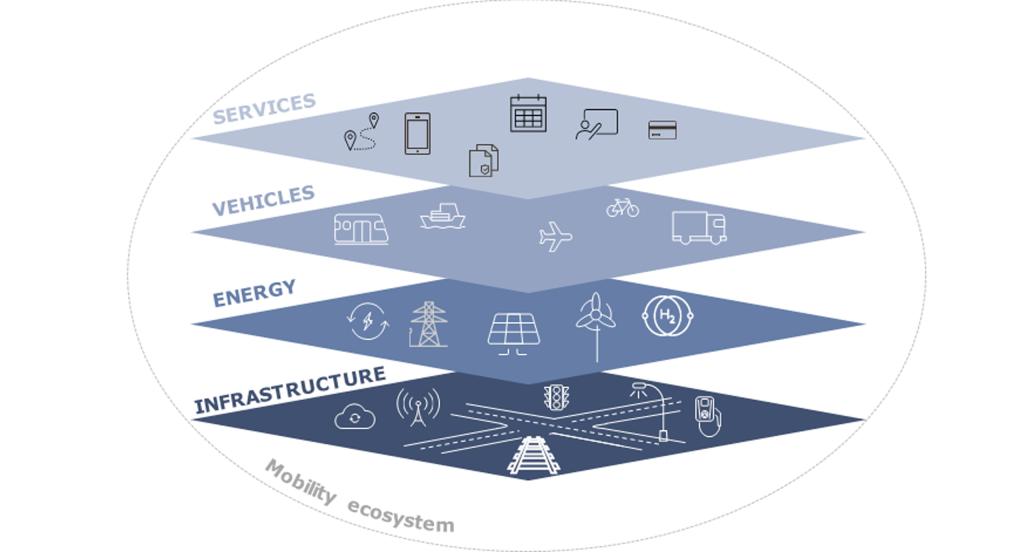
Five major trends to shape future mobility
Our Vision: Future-Proofing Mobility
Mobility is not only a technology but also a behavioural topic which impacts multiple layers. By combining capabilities, our Team has the potential to develop integrated mobility solutions that are accepted by mobility users as well as mobility providers.
Our Mission: Connect people & Share knowledge
Our mission is to connect, exchange and build knowledge related to mobility between offices & generations. We strive to foster the development of an expert network that drives the transformation of mobility, helping to share mobility needs across generations.
Mobility has been and will continue to be decisive for the development of society. Companies able to export and import goods and services beyond country borders contribute not only to economic growth but also to the development of knowledge, capabilities, and innovation. Individuals expand their horizons by travelling or working abroad to experience new impulses, and acquire new skills which are closely linked with social mobility. New linkages are established by moving physically, ultimately contributing to the changing dynamics of society and vice versa as seen in discussions related to sustainability.
Current trends in mobility are triggered by the question of how mobility habits and, in particular, the use of energy in transport can be adapted to mitigate impacts on the climate. Efforts are focused on decarbonisation by moving away from fossil fuels towards renewable energy. Technology for connectivity and automation increases efficiency in (energy) usage and mobility habits. With the latter experiencing efficiency in the form of sharing mobility, another trend can be identified. The most efficient way of mobility is staying as local as possible and moving as far as necessary, ideally on foot or by bike, and creates the desire for a “15-minute city” with liveable urban environments matching individuals’ and communities’ daily needs. Understanding the interaction between the five trends and the four layers of mobility allows us to have an impact in shaping mobility to the future needs and values of individuals and communities.
Continuously changing with society, the fundamental layers of mobility remain as infrastructure, energy, vehicles and services. Infrastructure allows mobility patterns and habits to be established with suitable vehicles. Here we differentiate between tangible i.e. streets, bridges, rails and the subsequently added intangible infrastructure e.g. the internet enabling shared mobility. The movement of vehicles requires energy and leads to the use of different energy sources. The utilisation of the products of the mentioned layers allows the offering of services and creates the connected fourth layer. Interaction between the layers of mobility and the needs and values of society results in trends.

1° Layer: Infrastructure
The “15-minute city” shows the shift to human-centric design and defines future features of infrastructure. During the pandemic, people strongly experienced the meaning of nature and green areas in cities for mental wellbeing. Cities can maintain the connection between human and nature. Nature can co-exist with rails and roads or harbours and airports, as seen in the recent Ellinikon project that intends to transform the old Athens airport into a liveable urban district. Infrastructure, real estate design and urban planning considering the needs of individuals and communities can maintain the link to and reduce the impact on nature. Appropriate use of technologies and the creation of mobility hubs and new concepts can enhance efficiency in the utilisation of infrastructure. Altogether, a smart infrastructure enables connected transportation that adapts to changes in traffic patterns. The infrastructure development towards the “15-minute city” can be accelerated by a strategic shared vision of urban organisation between local administrations and municipalities with the goal of ultimately meeting citizens changing needs. Our Team can be an active part in fostering this transition by promoting its socio-economic and environmental benefits among different generations.
2° Layer: Energy
Like traffic patterns, the use of energy in mobility changes and requires more diversity in the sources of energy to move away from fossil fuel to renewable sources in transport. Electric vehicle charging infrastructure, one of the most prominent topics in our client interaction and projects, shows that electrification is popular and fast for local decarbonisation. The implementation of electrification in transport brings challenges and opportunities, covering a range of actors from regulators to end-users and areas from raw material sourcing to installation at the sidewalk. And this is only one of the alternative fuel technologies. In many transport segments, as an example, hydrogen is a much-discussed energy source, which comes with another set of challenges and opportunities. A common aspect, apart from potential contribution to decarbonisation, is the fact that all of them bring new services and products in the form of energy sources and vehicles with them.
3° Layer: Vehicles
New fuel technologies in transportation are changing the powertrain technology; however, the form of vehicles is not only influenced by the energy source but also new technologies, especially related to connectivity and automation. Batteries and fuel cells to power vehicles are used to power vehicles more sustainably. Technologies for connectivity and automation could lead to new forms of vehicle, help to manage traffic flows, and enable new mobility behaviours. As an example, electric Vertical Take-Off and Landing aircraft (eVTOL) could be suitable for daily passenger and freight transport. Autonomous driverless vehicles could increase the efficiency in utilisation and sharing rate of infrastructure, energy and vehicles, and potentially reduce the volumes needed. While volumes in infrastructure, energy and vehicles could expand at a lower rate, the variety of services is rapidly expanding.
4° Layer: Services
Multimodal mobility solutions facilitate more efficient mobility habits and require mobility to be offered as a service. A traveller wants to plan, book, and access real-time information, pay and ticket in the easiest possible way, and mobility in the form of ride sharing/hailing or simply taking public transport in the most convenient way can be offered via an app. This makes mobile phones more important for mobility than the vehicles themselves. A growing number of technology and software companies are entering the mobility business via the service layer of mobility which offers the greatest opportunity to make it more sustainable and to disrupt our understanding of mobility.
Triggered by the focus on sustainability in mobility and technological possibilities, dominant trends have emerged, which are the shift to human-centric infrastructure, decarbonisation efforts with cleaner energy sources, increasingly connected and automated vehicles, and expanding the variety of mobility services. All of them are affecting other areas of mobility to a different extent. Assessments focussed on each layer in connection with other areas of the mobility ecosystem will allow us to understand if we experience a fundamental disruption or simply changes in the features of mobility.

Authors
- Alberto Navarini
- Lars Preuschoff
- Liang Dac Hoa
- Mustafa Bayansalduz